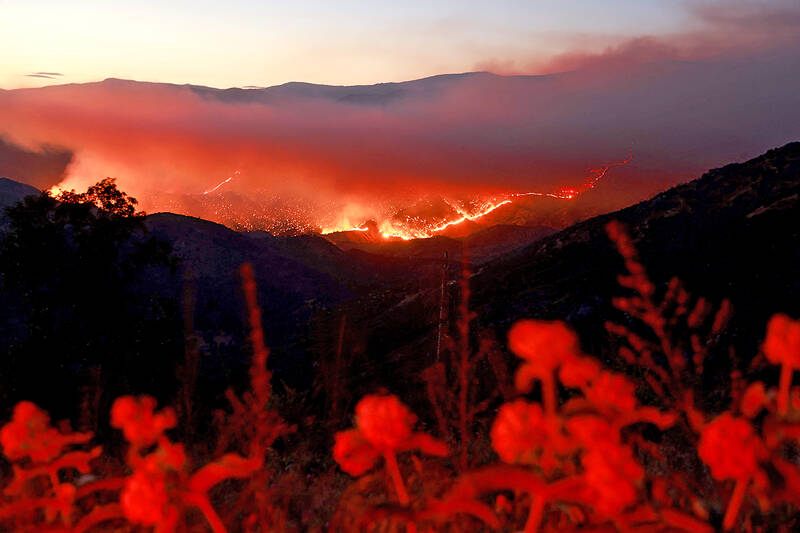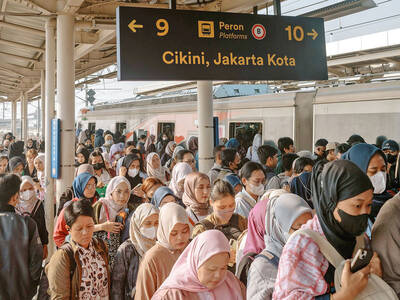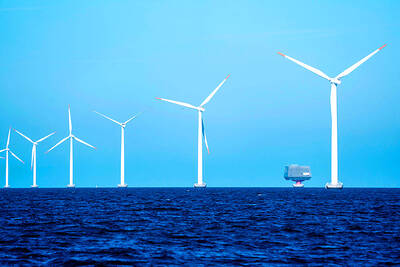From carbon pollution to sea-level rise to global heating, the pace and level of key climate change indicators are all in uncharted territory, more than 60 top scientists said yesterday.
Greenhouse gas emissions from burning fossil fuels and deforestation hit a new high last year, averaging over the past decade a record 53.6 billion tonnes per year — that is 100,000 tonnes per minute — of carbon dioxide or its equivalent in other gases, they reported in a peer-reviewed update.
Earth’s surface temperature last year breached 1.5°C for the first time, and the additional carbon humanity can emit with a two-thirds chance of staying under that threshold long-term — our 1.5°C “carbon budget” — would be exhausted in a couple of years, they said.

Photo: AFP
Investment in clean energy outpaced investment in oil, gas and coal last year two-to-one, but fossil fuels accounted for more than 80 percent of global energy consumption, and growth in renewables still lags behind new demand.
Included in the 2015 Paris Agreement on climate as an aspirational goal, the 1.5°C limit has since been validated by science as necessary for avoiding a catastrophically climate-addled world.
The hard cap on warming to which nearly 200 nations agreed was “well below” 2°C, commonly interpreted to mean 1.7°C to 1.8°C.
“We are already in crunch time for these higher levels of warming,” coauthor Joeri Rogelj, a professor of climate science and policy at Imperial College London, told journalists at a news conference.
“The next three or four decades is pretty much the timeline over which we expect a peak in warming to happen,” he said.
No less alarming than record heat and carbon emissions is the gathering pace at which these and other climate indicators are shifting, according to the study, published in Earth System Science Data.
Human-induced warming increased over the past decade at a rate “unprecedented in the instrumental record,” and well above the 2010-2019 average registered in the UN’s most recent Intergovernmental Panel on Climate Change report in 2021.
“I tend to be an optimistic person,” said lead author Piers Forster, head of the University of Leed’s Priestley Centre for Climate Futures. “But if you look at this year’s update, things are all moving in the wrong direction.”
The rate at which sea levels have shot up in the past few years is also alarming, the scientists said.
After creeping up, on average, well under 2mm per year from 1901 to 2018, global oceans have risen 4.3mm annually since 2019.

STEPPING UP: Diminished US polar science presence mean opportunities for the UK and other countries, although China or Russia might also fill that gap, a researcher said The UK’s flagship polar research vessel is to head to Antarctica next week to help advance dozens of climate change-linked science projects, as Western nations spearhead studies there while the US withdraws. The RRS Sir David Attenborough, a state-of-the-art ship named after the renowned British naturalist, would aid research on everything from “hunting underwater tsunamis” to tracking glacier melt and whale populations. Operated by the British Antarctic Survey (BAS), the country’s polar research institute, the 15,000-tonne icebreaker — boasting a helipad, and various laboratories and gadgetry — is pivotal to the UK’s efforts to assess climate change’s impact there. “The saying goes

FRUSTRATIONS: One in seven youths in China and Indonesia are unemployed, and many in the region are stuck in low-productivity jobs, the World Bank said Young people across Asia are struggling to find good jobs, with many stuck in low-productivity work that the World Bank said could strain social stability as frustrations fuel a global wave of youth-led protests. The bank highlighted a persistent gap between younger and more experienced workers across several Asian economies in a regional economic update released yesterday, noting that one in seven young people in China and Indonesia are unemployed. The share of people now vulnerable to falling into poverty is now larger than the middle class in most countries, it said. “The employment rate is generally high, but the young struggle to

ENERGY SHIFT: A report by Ember suggests it is possible for the world to wean off polluting sources of power, such as coal and gas, even as demand for electricity surges Worldwide solar and wind power generation has outpaced electricity demand this year, and for the first time on record, renewable energies combined generated more power than coal, a new analysis said. Global solar generation grew by a record 31 percent in the first half of the year, while wind generation grew 7.7 percent, according to the report by the energy think tank Ember, which was released after midnight yesterday. Solar and wind generation combined grew by more than 400 terawatt hours, which was more than the increase in overall global demand during the same period, it said. The findings suggest it is

FIRST STAGE: Hamas has agreed to release 48 Israeli hostages in exchange for 250 ‘national security prisoners’ as well as 1,700 Gazans, but has resisted calls to disarm Israel plans to destroy what remains of Hamas’ network of tunnels under Gaza, working with US approval after its hostages are freed, it said yesterday. Israeli Minister of Defense Israel Katz said that the operation would be conducted under an “international mechanism” led by the US. “Israel’s great challenge after the hostage release phase will be the destruction of all Hamas terrorist tunnels in Gaza,” Katz said. “I have ordered the army to prepare to carry out this mission,” he added. Hamas operates a network of tunnels under Gaza, allowing its fighters to operate out of sight of Israeli reconnaissance. Some have passed under